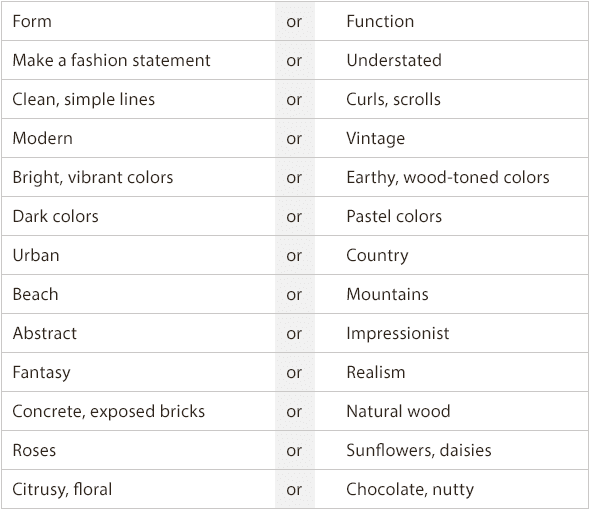Discover Your Style
STEP 1: Explore
Take a walk around your place (both inside and outside) and look at your surroundings. Ask yourself: What are the things you see that you really like? What are the things that you really don’t like? And then ask: What is it about the things you like that drew you to them? For the things you don’t like, ask yourself: Why would you replace them? And what would you love to replace them with?
As you look around your place (or your friend’s place, or your family’s place), take pictures of your favorite:
- Furniture
- Accessories and other décor
- Lighting fixtures
- Artwork
- Primary wall colors
Also, look for the colors and details of the accessories you like and notice how they accentuate the primary colors in the room. Here are a few details to get your creative juices flowing:
- Finish — is it:
- Silver/nickel/chrome
- Dark bronze/brown/black
- Brass/gold
- Glass — is it:
- White
- Clear
- Amber
- None
- Lines — are they:
- Straight and simple
- Angular/geometric/symmetric
- Assymetric
- Curvy
- Crystals — are they:
- Minimal
- Large
- Different sizes and shapes
- None
STEP 2: Opposites Attract
Often, what you want or like can also be discovered by identifying what you don’t like. So, here are some extremes you can pick between ( you are also allowed to waffle in the middle).
Of these two items listed side by side…which would you choose?

STEP 3: Gather Your Findings
Bring together the pictures you took and the words you chose that most connected with you. Compare them and contrast them. Look for common — as well as contradictory — elements, characteristics or themes. Pick out what you just couldn’t live without.
Share them with a friend and ask if these descriptions and attributes look and sound like you. And, as a bonus question, ask your friends if there is anything they would add.
STEP 4: High Five
Ta-da! You just put together your personal style guide. Although it might have seemed intimidating at first, it wasn’t that hard after all.
Now that you’ve got it, use it as your aesthetic blueprint to help guide you when choosing items (including lights) to make a room into an experience of you — and to transform a house into your home.
EXTRA CREDIT
Now that you have a good sense of your style and recognize the characteristics of what you like:
- Look for inspiration in our style pages.
- Browse through our product catalog or do some searches in the product area. While you’re doing this, go ahead and start making a Lighting List.
We will continue to build out this area, so keep coming back to find new tools to help you in your quest to discover your style.